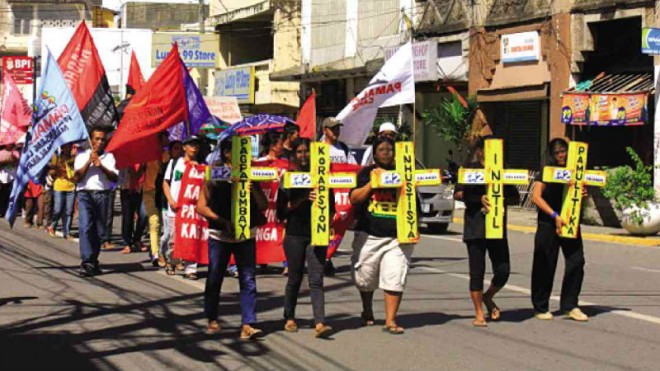
UNFAIR Survivors of Supertyphoon “Yolanda” march in Roxas City, Capiz, to protest alleged irregularities in the distribution of the government’s emergency shelter assistance. CONTRIBUTED PHOTO
(Last of a series)
ILOILO CITY— Former village officials Sonny Ciriaco and Fritz Ortiz traveled by motorboat for nearly an hour to reach Concepcion town on the Iloilo mainland and by bus for two-and-a-half hours to get to this city.
They sought assistance at the provincial capitol regarding irregularities in the distribution of emergency shelter assistance (ESA) for survivors of Supertyphoon “Yolanda” (international name: Haiyan).
They complained that several survivors living within 40 meters of the coastline at Barangay Malangabang in Concepcion off the mainland received cash grants of P10,000 to P30,000 even though this was prohibited under government rules.
Department of Social Welfare and Development (DSWD) Memorandum No. 24 excludes survivors living near coastlines, considered zones, from the ESA and instead offers to relocate them.
The DSWD central office has recorded or monitored 388 complaints related to the ESA as of Oct. 28. Of these, 263 were in Western Visayas, 95 in Eastern Visayas and 30 in Central Visayas.
Most of the cases involved exclusion or removal from the list of beneficiaries or irregularities in the distribution of P30,000 for families who lost their houses, and P10,000 for those whose houses were damaged.
The DSWD has responded to 351 complaints, while the rest are being attended to, according to a department report.
During a visit to Iloilo City on Sept. 10, Social Welfare Secretary Dinky Soliman said the number of complaints was minimal compared to the hundreds of thousands of families who had received cash assistance from the government.
Soliman said the complaints of irregularities indicated that the Aquino administration’s reform program had taken root and that the typhoon survivors were standing up for their rights.
“Citizens are actually holding us accountable, demanding assistance from barangay officials and government agencies,” she said.
But when asked if she believed the number of complaints reflected the actual situation, Soliman admitted that there could be more cases other than those actually filed.
Corazon Binoya, a social worker at the Tacloban City Social Welfare and Development Office, acknowledged irregularities in the distribution of the cash assistance.
“But we managed to correct or stopped them. After all, this is supposed to be given fair and square to all Yolanda victims whose houses were damaged or destroyed,” she said.
Binoya said complaints were being referred to a grievance committee headed by City Social Welfare and Development Office chief Gloria Fabregas.
Binoya said there were people who tried to cheat the government by enlisting twice and giving two separate addresses.
“For some reason, they were able to secure green cards, used as basis in giving the ESA, stating two separate addresses. But we checked them personally or through our master list,” she said.
Complaints
The DSWD has partnered with the Department of the Interior and Local Government (DILG) and the interfaith-based Ugnayan ng Barangay at Simbahan program in a project to monitor and deal with complaints involving irregularities in the distribution of the shelter assistance.
The project seeks to complement the monitoring of the DSWD and respond to complaints of survivors who have been delisted, and other concerns, Soliman said.
People found responsible for irregularities will be dealt with accordingly, she added.
But the Panay-based Kusog sang Pumuluyo, a regional alliance of typhoon survivors and their supporters, said thousands of survivors had been complaining about the delay and irregularities in the ESA distribution.
“The government has failed and continues to do so in effectively helping the survivors. The people have been victimized twice,” said Fr. Marco Sulayao, the group’s spokesperson.
Rehabilitation funds
Aside from problems with the release of the shelter assistance, there is the delay in the release of funds for the rehabilitation and recovery of the ravaged areas.
The watchdog group, Social Watch Philippines, said in a report that overall fund releases for the P170-billion Comprehensive Rehabilitation and Recovery Plan (CRRP) for areas affected by the typhoon had been below the expected level of accomplishment.
The group noted that fund releases to certain agencies were more than the planned funding requirements under the CRRP, while those for other agencies were below the requirements.
Citing data from the Department of Budget and Management, Social Watch pointed out that as of November 2014, P4.48 billion had been released to the DILG, 120 percent of the P3.731 billion in funding needs of the agency for the CRRP.
No overall manager
Social Watch also noted an “absence of an overall manager and coordinator to oversee the rehabilitation, recovery and reconstruction efforts of the government.” The absence of such an official could put the goals of the CRRP at risk, according to the group.
Former Sen. Panfilo Lacson resigned as presidential assistant for rehabilitation and recovery in February after submitting the CRRP to President Aquino.
While the National Economic and Development Authority is involved in the planning, preparation and review of development plans, including the CRRP, Social Watch said, the agency was also monitoring the whole country and is not an overall manager and coordinator for the monitoring of rehabilitation, recovery and reconstruction efforts.
“No one in the government is in charge of actually monitoring the progress of the rehabilitation in the Yolanda-affected areas, and no one is directing government efforts to ensure that the (‘Build Back Better’) goal is achieved and that the affected areas are now or will be more resilient to calamities and disasters,” it said.